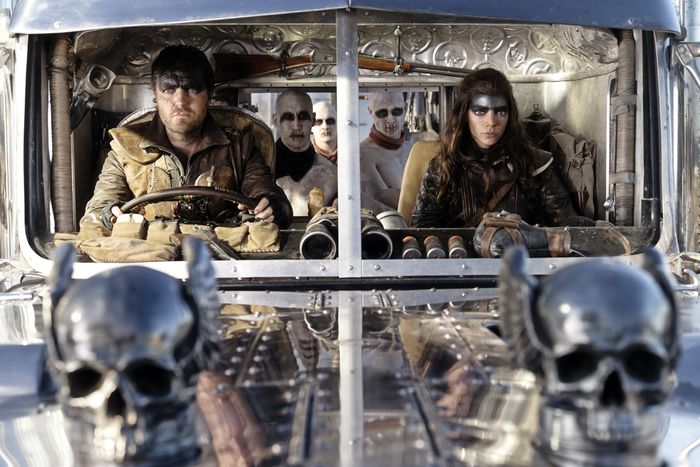
Light spoilers for Furiosa: A Mad Max Saga ahead.
The Mad Max world has never seen a character like Praetorian Jack — he’s not quite Max-ian, nor is he a hero, but when Jack enters about an hour into George Miller’s Fury Road sequel, Furiosa, he emerges as the beating heart of the dirty, sandy, heart-pounding desert epic. Though much of Furiosa is spent watching the titular heroine (Anya Taylor-Joy) trudge through dune and sludge to get revenge against Dementus (Chris Hemsworth), the crazed warlord who killed her mother, it’s in her relationship with Jack, as played by Tom Burke, that she finds her humanity once again. Together, the two develop a taciturn friendship, not unlike the one between Max and Furiosa in Fury Road, as Jack teaches her how to survive out in the Wasteland.
Burke’s résumé isn’t too similar to his co-stars’: You might have seen him in his breakout role as Anthony in Joanna Hogg’s The Souvenir or as Orson Welles in David Fincher’s Mank. Burke’s handsome, measured nature lends this otherwise splashy, gory flick a note of unexpected tenderness. We spoke to him over Zoom about flying halfway across the world to play in the desert.
How did you get involved in Furiosa? Is this the type of thing you go out for, or did George Miller come to you?
To my great surprise, George came to me. He’s seen The Souvenir and he’d seen Mank, and he thought I was the guy. It was a nice surprise.
Had you been seeking out a larger-scale blockbuster to work on?
Not in my most personal, private, “putting it out into the universe” was I ever like, “I want to run around with a gun.” Only for someone like George Miller, whose work felt like it was already on the terms of the work I’d been doing. I get offered quite a lot of tough-guy parts, but nothing like what George Miller does.
Your character, Praetorian Jack, feels somewhat in line with some of your past characters: a bit tragic, a bit Byronic. Did your approach change given the scale of the production?
We had immediate conversations about where he was from and what his existence had been like and how you keep your head down in that world, and then the revolution that is Furiosa coming into that world. I never felt like Jack existed in a vacuum. George was very particular and specific about the present moment of each piece.
I imagine you’d seen all the Mad Max films prior — did you feel conscious of the canon of them as you were shooting, or did you have to tune out your memories of what these movies are?
One imagines it would be enormously intimidating, right? I probably did have the moment where I was like [eyes wide, looking around], but credit to George and Nico Lathouris that for the most part, it felt like any other job. I knew their aspiration was that in this huge, great machine, this story was going to count in a very particular way, with the right kind of ambiguity and the right kind of heart. I loved that this was the aspiration, and I knew I was gonna give it everything. It’s still a surprise to me that it has been achieved, and I do feel like it’s been achieved. My friend says, “Only the impossible is worth the effort.”
Do you have a favorite Mad Max film, outside of the one you just made?
I really love Thunderdome.
It’s almost underrated at this point.
I love Tina Turner in it. I’ve always got a soft spot for something that might feel overlooked.
George has a lot of longtime collaborators, and I’m particularly obsessed with Jenny Beavan, who does the costuming for these movies. Can you talk a little about your very cool look in the film?
She’s great, a real light. I saw a sketch of the costume before I got out there. It was important to me that it did look like a practical uniform, rather than a personalized display like some of the other characters have, because Jack isn’t very comfortable with where he is.
It’s not until the uniform starts to get rips and tears that his personality really starts to emerge.
He’s bigger than his job.
You’ve worked with a lot of auteurs over the past decade: David Fincher, Joanna Hogg, Nicolas Winding Refn. Did it feel different coming to work with George?
It’s probably easier to talk about the similarities of all these great directors. They don’t get defensive. They’re happy to be asked questions. They understand and are aware of their own blind spots. They want that engagement to wrestle out these ideas. They want to be surprised. They want to go, “Oh, I didn’t realize I’d written it that way,” they want that excitement. Sometimes you work with people who are earlier into their career who feel like they have to know everything. It can start to feel like there’s no poetic ambiguity.
George Miller is known for being a meticulous storyboarder, but I’m curious if there’s room for discovery within that structure on set.
It’s interesting because there’s a blueprint of the shot, but then there’s everything that’s happening in terms of rhythm, where your physical center is in that shot, what everything feels like … It’s quite nice to have an outline there. It’s a bit like having a suit tailored, and then you’re going, “Oh, is it four buttons? Three?” The parameters are smaller, but it’s really enjoyable to make those choices in the scene.
What was something that came up for you as a big question as you were shooting?
There was an earlier sense of romance between Furiosa and Jack being very palpable in an earlier draft I read. It worried me. They’d made this deal that Jack would train her and she would help him on the road, and the deal needed to be done, on one hand, for there to be room for something to grow, otherwise it corrupted the deal. In talking with Anya, there was a sense of these people living such a particular kind of existence where a romance like that wouldn’t be as available to them, to think in that way or feel in that way. It’s really when their horizon changes and they’re driving away after that pursuit that suddenly there’s a question that’s not been there before. Some people have seen it as being there from the moment they look at each other, and that’s the kind of ambiguity I meant earlier. You don’t get that from being vague; you get that from being very, very specific, and then letting the audience feel whatever they want to feel.
There’s a really beautiful moment between Furiosa and Jack once things have gone really south for them: They are exhausted and almost just falling into each other, their heads almost bumping. Is it hard to access that tenderness amid other sequences that feel piecemeal or crazy to shoot?
It’s always interesting to see what feels freeing on the day. I don’t know if it plays that way in the film, but we did all of that in one long take. You’re getting pulled out of an upside-down car and doing circuits of being dragged — we did all that in one. You just feel that they’d be delirious. They’d be semi-concussed. They’d been in this whole other mind-set, and then the idea that in that moment, they’d just want to turn to each other, felt really freeing. If the reality is, “Oh, we’re gonna die,” we chose a very animal, or subconscious, thing to do.
More on Furiosa: A Mad Max Saga
- And the Winners of the 2025 Stunt Awards Are …
- George Miller Has Lots of Stories Left to Tell, and One of Them Is a New Mad Max
- The Third Annual Stunt Awards Are Here


